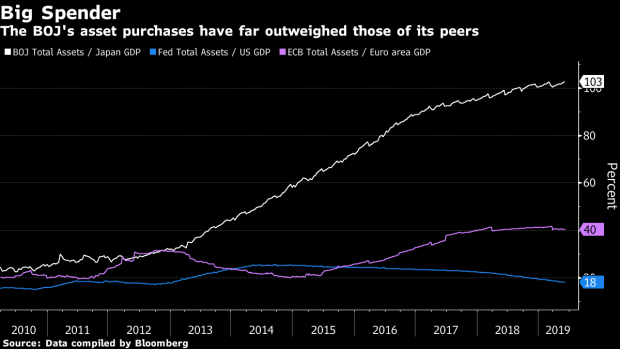Jun 19, 2019
BOJ Stands Pat as Fed and ECB Signal Possible Rate Cuts Ahead
, Bloomberg News

(Bloomberg) -- Terms of Trade is a coming daily newsletter that untangles a world embroiled in trade wars. Sign up here.
The Bank of Japan kept monetary policy unchanged Thursday, just hours after the Federal Reserve became the latest central bank to signal a willingness to cut interest rates in the face of rising threats to economic growth.
The BOJ maintained its interest rates and asset purchases, it said in a statement. All 50 economists surveyed by Bloomberg had predicted no change.
Governor Haruhiko Kuroda’s views on the economic outlook and the possibility of additional stimulus will be in focus when he holds a news conference at 3:30 p.m. He is likely to reaffirm his willingness to add stimulus, something he has repeatedly pledged to do if momentum toward the BOJ’s 2% inflation target is threatened.
For the first time in more than two years, a majority of economists now predict the BOJ’s next policy move will be to increase stimulus, and some see action as early as next month. Those expectations will be reinforced after both the Fed and European Central Bank this week indicated a readiness to shift to more accommodative policy.
Fed rate cuts, seen as increasingly likely, are expected to force the BOJ’s hand by pushing the yen to what it would consider an uncomfortably strong level.
In fact, in weighing its options the BOJ will primarily focus on Fed policy and its impact on the yen, Yasunari Ueno, chief market economist at Mizuho Securities Co., said before today’s decision. Ueno was among six analysts to recently predict the BOJ would increase stimulus next month.
A stronger yen would hamper the BOJ’s efforts to hit 2% inflation. Core inflation, to be released Friday, is expected to have fallen in May to 0.7% and is forecast to drop further in coming months.
Policy Dilemma
Still, it won’t be that simple. The BOJ faces competing concerns about risks to the economy and the accumulation of side effects from six-plus years of radical stimulus. Kuroda told Bloomberg last week that the bank still has room for big stimulus, if necessary, but he also stressed the need to be wary of side effects.
In any case, many economists doubt the BOJ could even have much impact. Its toolbox is almost empty -- complicating the risk-reward scenario for Kuroda and his fellow board members. While the Fed can cut its benchmark rate multiple times before it even approaches zero, the BOJ’s short-term rate is already at -0.1%.
Japan’s trade-dependent economy showed some resilience in the first three months of the year, but some economists are warning of a contraction in the current quarter. Exports fell for a sixth-straight month in May, data released Wednesday showed.
The BOJ still expects conditions to improve in the second half of the year, but escalating trade tensions are heightening concerns about global demand among policy makers and businesses.
Policy Recap
- Pledge to keep interest rates extremely low until at least around spring of 2020.
- A rate of -0.1% on some reserves financial institutions keep at the central bank.
- Yield target of about zero% for 10-year Japanese government bonds, with a trading range of about 0.2 percentage point on either side of the mark.
- A target of increasing JGB holdings by about 80 trillion yen ($737 billion) a year is now secondary to controlling interest rates. The actual pace of purchases has fallen to well below half that rate.
- A guideline to increase holdings of exchange-traded funds by 6 trillion yen a year. Actual purchases vary widely from month to month, depending on market conditions.
To contact the reporter on this story: Toru Fujioka in Tokyo at tfujioka1@bloomberg.net
To contact the editors responsible for this story: Brett Miller at bmiller30@bloomberg.net, Henry Hoenig, Paul Jackson
©2019 Bloomberg L.P.